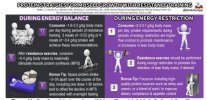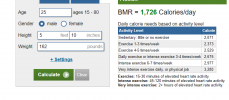Yep!So it sounds like I stay the course.. tweak the exercises next go
Perfect.I am currently doing S&S 2x week as well
Yep!So it sounds like I stay the course.. tweak the exercises next go
Perfect.I am currently doing S&S 2x week as well
or do your clothes fit differently (tighter in neck and shoulders, looser around waist)? This is sometimes first obvious sign.Have you tried taking a before and after photo?? Sometimes the scale doesn't budge much but you look different..
This is actually part of the issue.. clothes are looser - but at 162lbs I feel like I dont have more room to go down .. idea is not to lose weightor do your clothes fit differently (tighter in neck and shoulders, looser around waist)? This is sometimes first obvious sign.
Do you feel like you have added muscle with easy strength?I'm in the middle of running Easy Muscle on the clean-and-press only schedule. I'll use a sewing measuring tape to try to measure results at the end of the program but shirts feel tighter than they did before I started the program.
From what I understand of recent hypertrophy research, the choice of training tool does not matter as long as the volume is high enough to stimulate muscle growth, preferably with a 10-rep max load or whatever load your program of choice recommends. The same research I looked at also says hypertrophy resulted from training with a light load, but only if reps were done to failure - which is has some consequences- eg. maybe needing more recovery days between workouts vs. not training to failure.
I prefer kettlebells and suspension trainers because they're very forgiving on my joints compared to other equipment I've tried.
I've run Easy Muscle A once and the Giant several times and found both added muscle around my shoulders and upper torso.Do you feel like you have added muscle with easy strength?
Eat more.This is actually part of the issue.. clothes are looser - but at 162lbs I feel like I dont have more room to go down .. idea is not to lose weight
Actually, research (e.g. Schoenfeld et al.) shows that similar hypertrophy can be achieved with a wide range of load (>30%1RM), as long as the reps are done "close to failure", mostly 0-5 reps in reserve, where going to failure (0 RIR) is very taxing on you CNS, but does not contribute much more to the hypertrophic stimulus.From what I understand of recent hypertrophy research, the choice of training tool does not matter as long as the volume is high enough to stimulate muscle growth, preferably with a 10-rep max load or whatever load your program of choice recommends. The same research I looked at also says hypertrophy resulted from training with a light load, but only if reps were done to failure - which is has some consequences- eg. maybe needing more recovery days between workouts vs. not training to failure.
Helpful. Thank youEat more.
60% of hypertrophy is nutrition. If not eating enough, any program becomes a weight loss program.
Do you track your nutrition?Helpful. Thank you

For sure!S&S twice a week isn’t going to do much at all for hypertrophy.
This is becoming more and more accepted. Look into Chris Beardsley’s work on hypertrophy. The short of it is that a “hard set” means the individual muscle fibers are experiencing a high degree of mechanical tension. More researchers (including Schoenfield, IIRC) are starting to think that mechanical tension is not only a key factor for hypertrophy but might be THE key factor. Going “close to failure” means you end up exerting a lot of tension towards the end of the set. That’s what’s meant by a “hard set.” It also helps explain why varying rep and loading ranges result in hypertrophy.number of hard sets is more important than load
I eat between 2100-2300 cals; 150-160g protein and fill out the rest with carbs / fats — typically higher fatsDo you track your nutrition?
What are your calories, protein, carbs, and fats each day?
Make sure you're getting at least 1 gram of protein per pound of lean or goal body-weight (this is non-negotiable). You can go up to 1.5-2 grams per pound of lean or goal body-weight especially if you're eating lower carbs.
Research is clear on this especially for fat loss (you need more protein then):
View attachment 21562
Has your weight gone up or down while following BuiltStrong Minimalist?
Eat more.
60% of hypertrophy is nutrition. If not eating enough, any program becomes a weight loss program.
I eat between 2100-2300 cals; 150-160g protein and fill out the rest with carbs / fats — typically higher fats
I am 6 weeks thru BuiltStrong minimalist and whilst I feel stronger, cannot tell necessarily I gained muscle mass

Imma push back on this a little. Personally I believe what works best might vary from person to person, but I stand close to Thib when he (paraphrase) says to do enough to trigger muscle synthesis and then get out of the gym.So number of hard sets is more important than load.
